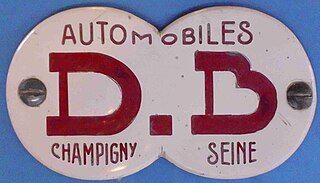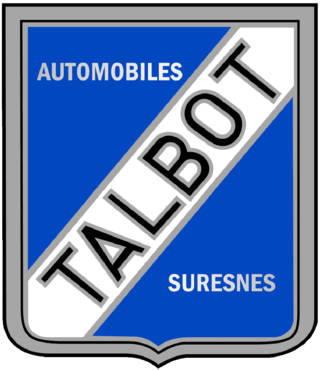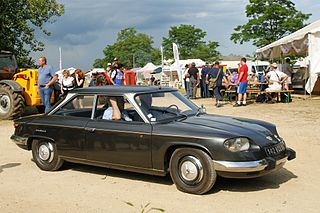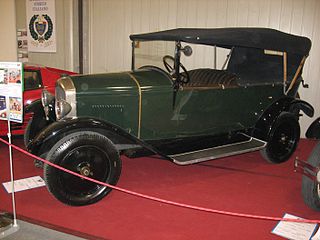This article needs additional citations for verification .(February 2009) |

The Arista was a French automobile with a fiberglass body, produced in Paris from 1952 to 1967.
This article needs additional citations for verification .(February 2009) |

The Arista was a French automobile with a fiberglass body, produced in Paris from 1952 to 1967.
The firm had been founded in the late 1940s by Antonio Monge and Robert Rowe under the name Callista, but the two fell out over the future direction of the firm after its original project, a sporting model called the "Coupe des Alpes" first seen in prototype form at the 1950 Paris Motor Show, appeared likely to be severely undercut on price when Panhard themselves launched their Panhard Dyna Junior with a comparable level of performance at a far lower price than Callista could achieve with their elegant low volume cars. [1] Monge resolved to return to his former occupation, preparing cars for motor sport events. [1] Shortly after this setback Rowe, who had previously worked as an electrical engineer with the Fulmen business, but who also engaged in other trading activities, suddenly found himself financially ruined after he imported to France several hundred Romanian tractors that turned out to be defective. [1] At the end of 1952 both the firms founding partners, for their own different reasons, withdrew from the project. [2] [3]
The enterprise was rescued by Raymond Gaillard, also known in the automotive world as a regular competitor in the Le Mans 24 Hour race. Up to this point Gaillard had figured in the Callista business only as a substantial investor and potential sales distributor for the "Coupe des Alpes" model. [1] Gaillard rescued the residual elements of the business and refounded it under the new name of Arista. [1] From now on the firm concentrated on a smaller lighter and presumably cheaper model called the "Arista Ranelagh". The Ranelagh names came from the (then as now) fashionable Paris street, Rue du Ranelagh where Gaillard owned a Panhard dealership.
Again based on the mechanical components from the Panhard Dyna X, the car was a low cabriolet with long overhangs at each end, reflected in the difference between the 2130 mm wheelbase and the 4100 mm overall length of the cabriolet model. [1] There was a shorter roadster of only 3620 mm in length. [1] The car weighed only 550/640 kg and a top speed of between 135 and 140 km/h (between 84 and 87 mph) was claimed. [1] Both the light weight and the front-wheel-drive layout were determined by the car's Panhard underpinnings. [1]
About 100 were made.[ citation needed ]
1956 saw the arrival of the Arista Passy, powered by the 42 CV 848 cc engine from the Panhard Dyna Z, and still listed in 1962. A model with the 50 CV "Tigre" engine was sold as the Arista Sport, although the weight savings over a regular PL17 was only about 80 kg (180 lb) due to the car's ample equipment. [4] The little Arista coupé, though stylish, had by now become extremely expensive for a car of this engine size and performance. [5] Sales seem to have slowed to a trickle.
Other Arista designs appeared from time to time, but it is not clear if any others made it to production. Arista had disappeared from view by 1963, although the same business was later involved in making the Sovam sports car. [6]

Deutsch-Bonnet (DB), is a brand of sports cars created in 1937 by Charles Deutsch and René Bonnet and disappeared in 1962.

Facel S.A. was a French manufacturer of pressed steel automobile components, later complete automobiles of their own design.

Panhard was a French motor vehicle manufacturer that began as one of the first makers of automobiles. It was a manufacturer of light tactical and military vehicles. Its final incarnation, now owned by Renault Trucks Defense, was formed by the acquisition of Panhard by Auverland in 2005, and then by Renault in 2012. In 2018 Renault Trucks Defense, ACMAT and Panhard combined under a single brand, Arquus.

Matford was a French automotive manufacturer established as a joint venture in 1934 by local firm Mathis and US-based Ford Motor Company. The name Matford derived from both companies' names. The company ceased activities in 1940.

Talbot-Lago was a French automobile manufacturer based in Suresnes, Hauts de Seine, outside Paris. The company was owned and managed by Antonio Lago, an Italian engineer that acquired rights to the Talbot brand name after the demise of Darracq London's subsidiary Automobiles Talbot France in 1936.

The Panhard Dyna Z is a lightweight motor car produced by Panhard of France from 1954 to 1959. It was first presented to the press at a Paris restaurant named Les Ambassadeurs on 17 June 1953 and entered production the following year. In 1959, it was replaced by the Panhard PL 17.

The Renault Caravelle is a sports car manufactured and marketed by Renault for model years 1958–1968 in a single generation — as a rear-engine, rear-drive open two/four-seater designed by Pietro Frua of Carrozzeria Ghia, using the floorpan and engine of the Renault Dauphine.

The Panhard PL 17 is an automobile made by the French manufacturer Panhard from 1959 until 1965. Presented on 29 June 1959, as successor to the Panhard Dyna Z, the PL 17 was essentially a facelifted version of its predecessor. The initial four-door saloon was joined by the Cabriolet in 1961, and by the Break, a five-door estate version, in April 1963. The Break, developed by Italian company Pan Auto, sat on a longer wheelbase but was of the same overall length.

The Simca Aronde is an automobile which was manufactured by the French automaker Simca from 1951 to 1964. It was Simca's first original design, as well as the company's first unibody car. "Aronde" means "swallow" in Old French and it was chosen as the name for the model because Simca's logo at that time was a stylized swallow.

Émile Darl'mat (1892–1970) was the creator and owner of a Peugeot distributor with a car body business established at the rue de l'Université in Paris in 1923. In the 1930s the firm gained prominence as a low volume manufacturer of Peugeot-based sports cars. Business was interrupted by the Second World War, but at least one prototype was kept hidden throughout the period and directly after the war Darl'mat returned to the construction of special bodied Peugeots, although in the impoverished condition of post-war France business never returned to the volumes achieved during the 1930s.

The Panhard 24 is a compact two-door coupé automobile produced between 1964 and 1967 by French manufacturer Panhard. It was powered by a front-mounted air-cooled two-cylinder boxer motor: the basic design of this unconventional engine dated back to the 1940s. In 1965, a lengthened Panhard 24 was launched and promoted as a two-door four- or five-seat saloon. Plans for a four-door version which might have enabled the car more effectively to replace the commercially successful Panhard PL 17 saloon were never implemented, however.

Corre La Licorne was a French car maker founded 1901 in Levallois-Perret, at the north-western edge of central Paris, by Jean-Marie Corre. Cars were produced until 1947.

The Peugeot Type 181, also known at the time and normally advertised simply according to its fiscal horse power as the Peugeot 11HP, was a mid-range car produced between 1925 and 1928 by the French auto-maker Peugeot at their Audincourt plant.
Lambert was a French automobile manufacturer established by Germain Lambert in 1926 at Mâcon. In commercial terms, it never progressed beyond marginal viability and it withdrew from auto-making towards the end of 1953.

Marathon was a French automobile manufacturer established by a group of engineers under the leadership of a rally enthusiast called Bernard Denis. Prototypes for a lightweight sports coupé were presented at various motor shows starting with the 1951 Frankfurt Motor Show and the cars were produced between 1953 and 1955.

The Panhard et Levassor Dynamic is a large car introduced by the French auto-maker Panhard et Levassor as a replacement for the company’s CS model at the Paris Motor Show in October 1936.
Paul-Marie Pons was a French naval engineer who became a senior civil servant. He is remembered for the Pons Plan which restructured the French automotive industry in the second half of the 1940s.

The Nervastella is a large automobile constructed by Renault between 1930 and 1937. It was used as a state car and pictures of the president of the French Republic sitting in a Nervastella can therefore be seen in newsreels from the mid-1930s.

The Panhard CS is a luxury car, most commonly sold with a four-door sedan/saloon body, introduced by Panhard & Levassor at the end of 1929 for the 1930 model year. It was presented as a smaller companion model to the 8-cylinder Panhard DS model. Publicity of the time indicated the "S" in the name stood for "surbaissées"
Jacques Durand was a French engineer, model builder and automobile designer. He is primarily known for designing several sports cars, which were built in small volumes in France beginning in the 1950s and continuing into the 1990s.